Cold Temperature Reports
Current Temperature Update (4-30-17)
Back to the main Wheat Freeze Damage page
Here is your update on the wheat conditions...this email is likely going to be a little long because we have a lot to talk about.
The snowfall was fairly different across the Sunflower District. Parts of Wallace Co had 18+ inches of snow that weighed the snow down in the field. In other parts of Cheyenne Co, there was snow that melted quickly and didn't really accumulate for long on Saturday and Sunday.
All in all, we need to wait 10-14 days to fully understand the full effects of the winter storm. We are looking at two types of damage – the physical damage to the stems from bending/kinking and the cold damage to the growing point and developing head of the wheat plant.
For the wheat that is/was under snow, we are looking at the stems at the base of the plant. Some of the stems are kinked/bent in the internode region (between the joints). In addition, at some of the joints the plants are bent and may be broken. Finally, there are some stems that seem to be in good shape with no kinks. As the snow is melting, the wheat seems to be standing back up slowly. The concern with the bent stems is that the sugars, nutrients and water that move up and down the stem to the growing wheat head are being limited. This is because of the xylem (conducts water and nutrients) and phloem (conducts sugars) have been damaged by the bending of the stem. Looking down the road, the place where the wheat stem is bent is going to be a weak spot. This could result in lodging of the wheat during the rest of the growing season or at harvest.
This is from the field around the Wallace County Wheat Plots at Mai Farms. There was 18" of snow that fell here.
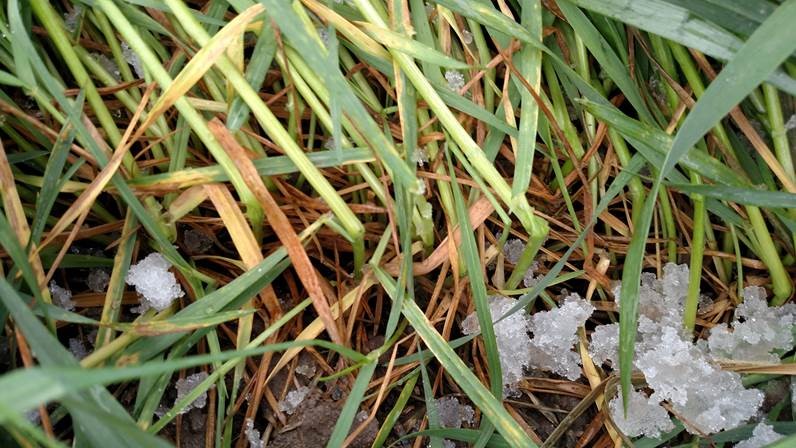
In addition, there may be bending of the stem/leaves above the developing wheat head. That could result in the head or awns getting trapped in the leaf and emerging in a U shape out the side of the boot.
Now, the tougher question is related to the cold damage to the growing point and the developing wheat head. This is the damage that can take a bit longer to show up. Many are asking about how long a stem can be encased in snow before damage occurs. Well, I haven't found a great deal of data to help answer that question. We haven't had an event quite like this that we can remember. Most times when we get snow at this point of the growing season, the snow melts off within a couple hours. So, the short answer is that we really just don't know yet and time will help us understand this better. There are other factors to think about also... how long was is encased in snow, how close was it to the soil surface (because there was likely warming because of the soil temperatures), and where was that head in the wheat stem (how many layers of leaf sheaths were covering and protecting it).
To know if there is damage to the developing wheat head, you need to split open the stem and look at it. A healthy wheat head will be pale green to green in color. It will feel turgid (full of water). If the wheat head is a dull white to yellow color and it feels mushy, then there is damage to that developing head. This type of damage may not be showing up yet, so you may need to wait a little longer to assess this. It can take up to 2 weeks after the event to see this type of damage (especially in cases where there is still snow).
This picture is from May 2006, when we had a freeze event. I believe the wheat was just a bit farther along in development, but it will give you an idea of what to look for. The stem in the center of this damaged head is still green, whereas they may appear a yellowish color.
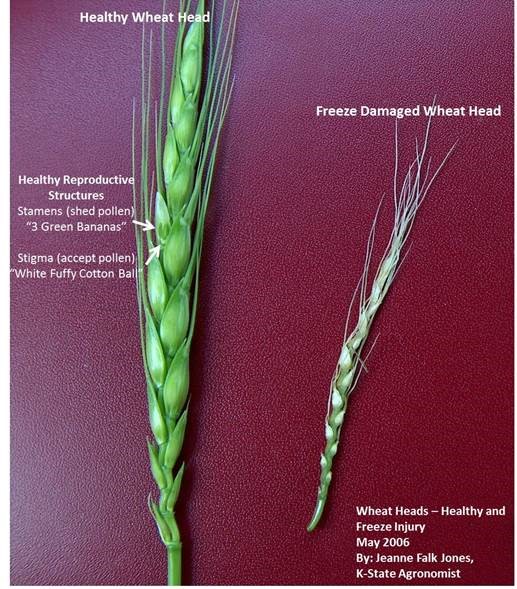
Now, what about if your wheat was not covered with snow? The overnight lows did not reach below 28 degrees for an extended period of time, so I think the wheat likely slipped by with no injury. If you are out looking at your wheat, you may see some purpling on the stems of the plants. That purple color is a reaction to cool temperatures and is a place on the plant that may have been a bit more tender (an area on the stem that just pushed out of the whorl). The purple color is from an accumulation of sugars, that have a purple pigment in them. This does not mean there is damage to the head inside the stem, just that the plant is reacting to the cold temps.
Here purpling on the stems at the south edge of the Cheyenne Co Wheat Plots. The purpling showed up on the stems that were on the edges of the plot.
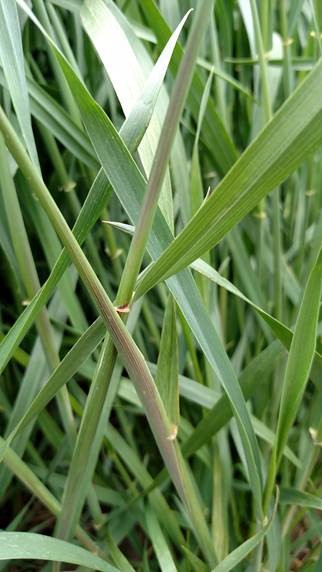
You may also be seeing whitish patterns on the leaves, likely the flag leaf. The discoloration on the leaf surface is from exposed leaves, snow and high winds during the blizzard. The whitish appearance is from damage to the cells and the cells loosing moisture. This is also seen in many years, sometimes on the edges of fields from blowing soil or sand from the road. This picture was taken at the edge of the field at the wheat plots at Mai Farms in Wallace Co. These leaves were not covered with snow.
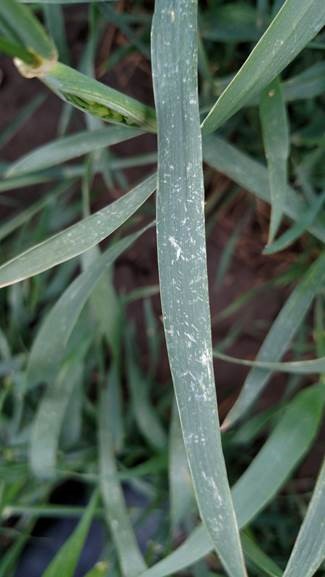
Both the purpling on stem and the whitish damage on the leaves may be found in the areas with the snow (exposed leaves) or in areas that the snow didn't last as long.
I have a couple videos posted on facebook showing the how the wheat looks under the heavy snow. And for you non-facebook users, you do not have to have a facebook account to watch the video.
This video is from the wheat plots at Mai Farms, where there was 18" of snow. I recorded this video on Monday evening (after they broke a path for me to get to the plots and made sure I had 4-wheel drive!).
Link: https://www.facebook.com/kstatesunflowerdistrict.agronomy/videos/1318858901542709/
The second video is on the Experiment Station in Colby on Tuesday around noon. The official total for Colby was 17" of snow. That was recorded about 150 yards from where I shot the video.
Link: https://www.facebook.com/kstatesunflowerdistrict.agronomy/videos/1319047998190466/
At the moment, there are many unknowns on the wheat that was under snow for quite a while (and some that is still under the snow). Ten to 14 days will tell us a great deal... Wheat is a pretty dynamic crop. If there is damage to a stem, the plant will likely try to reallocate resources to the non-damaged tillers. And, there is quite a bit of moisture to push the wheat plant along!
Cold Temperature Update (4-30-17)
There is a pretty dramatic difference of snow accumulations across the Cheyenne, Sherman and Wallace Counties! I am in Cheyenne County, where nearly all of our snow has melted (except for a little bit piled against the shop). The snow really hasn't accumulated much and some fell as rain, since it all started yesterday morning. However, seeing pictures from southern Wallace County...you guys are looking out across white covered wheat fields and 18" drifts in yards. So, it's going to be difficult to cover all of the bases, but I am going to quickly try.
Here are the overnight lows and soil temperatures at 2" depth. Two hours of 28 degrees can be damaging to wheat at the boot stage of development. What about wheat that has snow around the stem where the head is located? Well, that is a great question, but I don't have a good answer on that yet. If there is any damage to the growing point and developing wheat head, it will not become evident for 10 to 14 days. Therefore, it is too early to assess plants for this type of freeze damage.
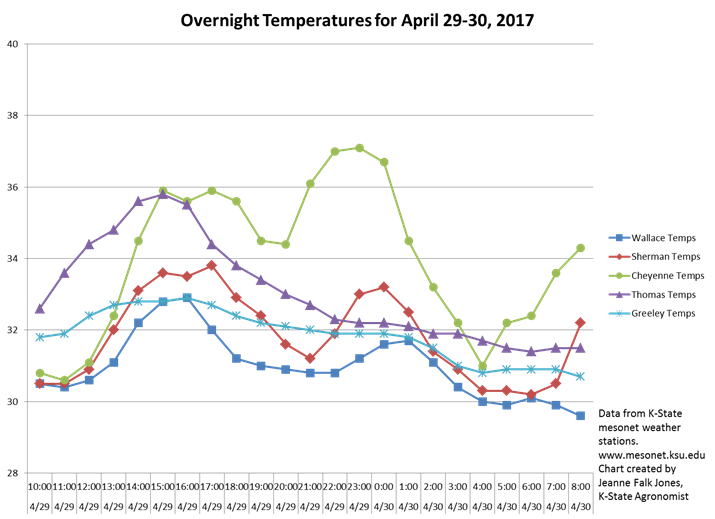
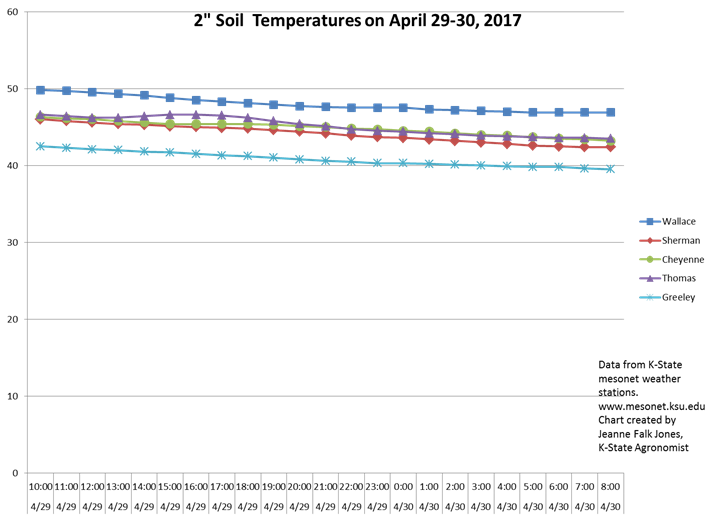
Right now, you can check for severe bends/kinks in the stems of the wheat from the weight of the snow. Besides the overall weakening of the stem (and potential problems with lodging), severe bends of the stem can limit the amount of water and nutrients moving into the developing tissues. It is also really too early to assess the amount of damage associated with kinks/bends in the stem.
Here are pictures from south of Weskan. The farmer reported that some (but not all) of the wheat stems are bent near the ground.
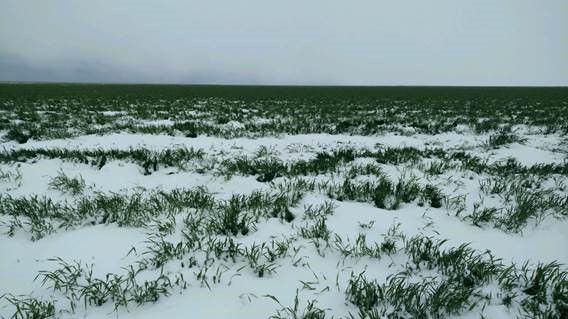
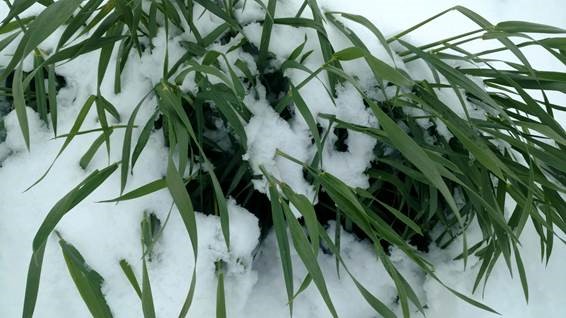
All in all, remember that wheat is a dynamic and sometimes very surprising crop! In visiting with Jim Shroyer (retired K-State wheat specialist) the last two mornings, he said the best thing to do on potential freeze damage on wheat is to be patient. I know that it hard to do, but the wheat needs to start growing again, so we can tell where the damage is (or isn’t)!
How chilly did it get last night? There was light frost on the hoods of pickup at our house early this morning (in Cheyenne Co). A light frost at this stage of wheat development doesn't worry me too much, but I thought I should go ahead and put together weather data his morning!
Here is the weather data from the local K-State mesonet stations. The lowest temperature chart shows how cold we were. We just touched those low temperatures and then rebounded back up. Our temperatures are the lowest in the state last night/this morning.
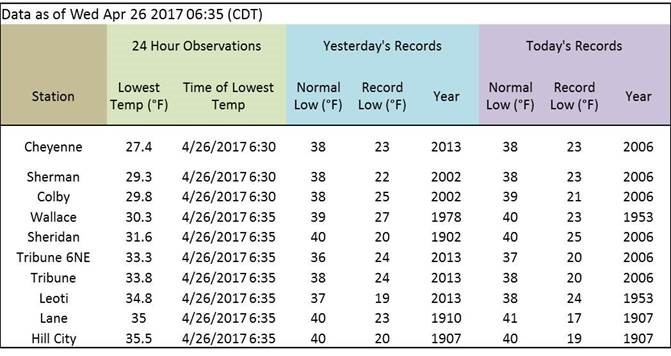
Data from the K-State mesonet weather stations.
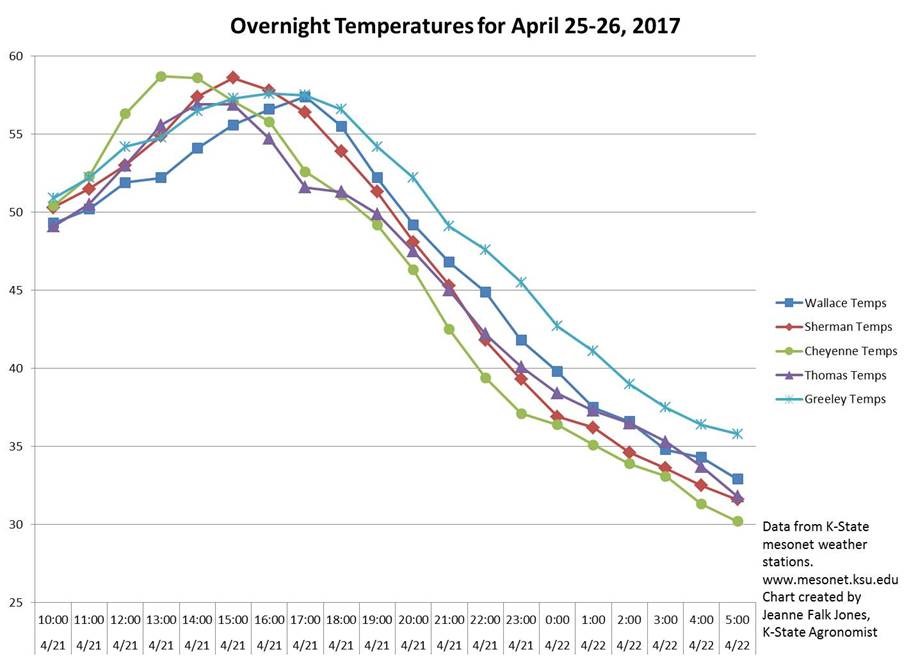
The injurious temperature for 2 hours is between 24 and 28 degrees for our wheat in the Sunflower District (Cheyenne, Sherman and Wallace Counties). It is inching closer to that 28 degree mark because out wheat is now starting to put out flag leaves (even though the head is still very protected in the stem).

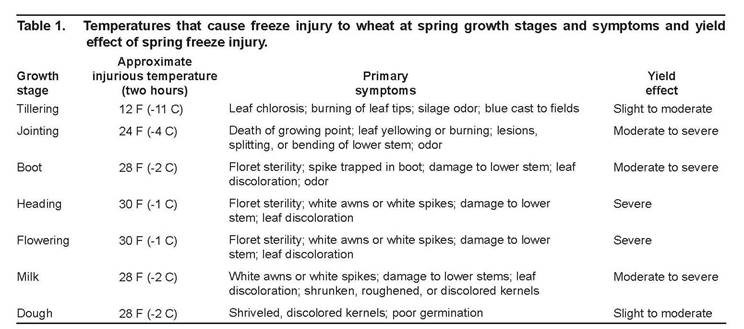
Source: Kansas State 'Spring Freeze Injury to Kansas Wheat'. C-646.
Here is a picture that I snapped from the K-State wheat plots in Cheyenne County yesterday evening. The flag leaves are really starting to show up in many varieties in the plots. The flag leaves may not be this far out in wheat fields throughout the area.
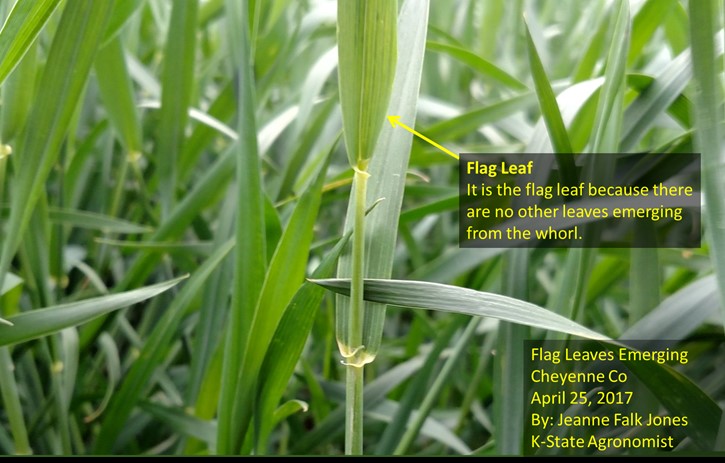
From the forecast, it sounds like the next few days may be a little rocky for weather and temperatures. I'll keep you in the loop of what I am finding!
If you have any questions, please let me know!
Jeanne Falk Jones
